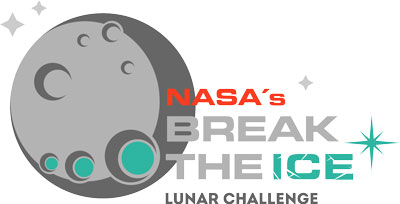As NASA works to extend human exploration of the solar system, human presence on the Moon will be critical for developing and testing the technologies and systems needed for future missions to Mars and beyond.

The NASA Break the Ice Lunar Challenge is designed to incentivize demonstrations of technologies that could support the Moon missions in a responsible, maintainable and reliable way.
In situ resource utilization (ISRU) – the development of lunar materials for life support, fuel, energy, manufacturing and construction – is necessary to limit the delivery of supplies from Earth.
One of the most important of these resources is water. Water supports all life on Earth and will be critical to supporting human exploration beyond Earth. On the Moon, water is trapped in icy regolith at the lunar poles, including inside permanently shadowed regions (PSRs).
The Break the Ice Lunar Challenge will take place over two phases, totaling up to a $5 million prize purse. Phase 1, opened in November 2020, seeks new ideas and approaches for a system architecture capable of excavating and moving icy regolith and water on the lunar surface.
Eligible participants must submit a system architecture report, excavation plan and mission animation by June 18, that addresses various operations and environmental conditions of a hypothetical excavation mission on the lunar surface. The entries will compete for a portion of the $500,000 Phase 1 prize purse.
The initiation of Phase 2, the demonstration phase, is contingent on the emergence of promising submissions in Phase 1 that demonstrate viable approaches to achieving the challenge goals. Phase 2 would carry a prize purse of up to $4.5 million.
Description
NASA has identified several technology gaps related to harvesting and moving large quantities of resources on the Moon, including hardware capable of operating in the extreme cold and permanent to near-permanent darkness. Robotic systems for excavation will need to withstand the harsh environments inside permanently shadowed regions at the lunar South Pole, where ice has been observed and the targeted landing site for crewed Artemis missions.
Phase 1 of the Break the Ice Lunar Challenge is focused on incentivizing new ideas and approaches to a system architecture for excavation and movement of icy regolith and water on the lunar surface.
Designs for this challenge will need to dig up the icy regolith, take it to a processing plant for water extraction, and then transport it to a storage tank for life support and other systems.
Following Phase 1, NASA may initiate a Phase 2 of the challenge, which is expected to focus on designing and building excavation hardware components and/or systems that would be tested in simulated lunar conditions.
Participating teams are given a hypothetical Mission Scenario and asked to design a system architecture addressing necessary hardware, concept of operations, lunar environmental conditions, and specific performance analyses. The team must also submit supporting materials that address credibility and feasibility of the proposed system architecture.
The hypothetical Mission Scenario takes place in and around a permanently shadowed region near the lunar South Pole and is similar to a real-world lunar mission. In this scenario, the mission will last 365 Earth days and includes three NASA assets: a NASA power plant, NASA power distribution, and a NASA water extraction plant. Teams are not required to use these assets.
Teams must:
- Excavate icy regolith at the excavation site.
- Extract water from that icy regolith using the NASA water extraction plant or their own method.
- Deliver that water to the delivery site.
Although there is no minimum mass of water that must be delivered, NASA is most interested in system architectures that can deliver at least 10,000 kg of water over the duration of the mission. Teams that credibly meet this goal are expected to be scored as having met expectations for the scoring criteria “Estimated Mass of Water Delivered.”
For more information on the Break the Ice Lunar Challenge, visit: www.nasa.gov/breaktheice
